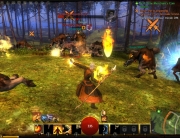I really like side-scrolling platform games. But I hate playing them on the phone.
One of the commonly shared problems among these games is the poorly implemented controls. Yes, I’m talking about virtual joysticks and directional pads in mobile games. I’m not saying these controls err by default. But they pose as uncouth solutions, the byproduct of a limited thinking that fails to adjust the essence of a genre to a new platform.
Mikey Shorts is a great example of how to do things right. Apart from teaching a lesson in the proper implementation of mobile controls, it also offers lessons in the design adjustments required to port familiar console experiences to mobile.
Console platformers traditionally rely on the player’s interaction with a physical controller — the resulting feedback, created from the incremental manipulation of a controller, physically links and heightens the in-game feedback occurring on the screen. It is this precise manipulation and timing — via a physical object — that elevates the core experience of a platformer. For example, most of us have very physical and tactile memories associated with playing Super Mario World. I remember twisting side-to-side with the false belief that this physical pretzeling would somehow create enough of a change to help me grab that extra life.
This physical aspect of playing a game isn’t exclusive or new to video games. This has existed in everything from the tilting of the pinball machine, to the tactile feel resulting from the meticulous weight with which we move chess pieces on a board.
That’s why the majority of virtual joystick and directional pad implementations are so frustrating — they function under the pretense that simply tacking on such controls will magically create the physical feedback that is absent on a phone or a tablet.
Mikey Shorts simplifies the directional pad by removing the vertical axes. This reduces the physical feedback required to communicate the nuance of multiple directions by 50%. With this simplification to strictly horizontal movements, the player is given a clear physical demarcation between two directions. That is a more digestible and tangible mobile game experience than the resulting rugburn on your thumb from multi-directional virtual joysticks. The multiple axes of virtual joysticks require too much directional nuance without providing the requisite physical feedback.
I’ve seen this control scheme in earlier mobile games like Mos Speed Run and League of Evil. What Mikey Shorts accomplishes, however, is to take that scheme and design a platforming game that feels native to the mobile platform. These earlier games fail to address the larger design issue — the forcing of a precision-based console game experience onto the fluidity-based mobile platform.
A side-scrolling platforming or action game experience on the phone has to be designed for fluidity, rather than precision. The limited real estate on mobile devices (excluding tablets here, of course) means that precision has to be enormously forgiving; and that allowing such breadth in the player’s input shifts the emphasis on the fluidity of the game’s experience. Without access to this flow, players will have a frustrating experience with their inability to achieve the precision demanded by the game.
In other words, remove the gates and let the player experience the flow (in this case, running and jumping in a mobile game).
Mos Speed Run and League of Evil, like console platformers, are at heart precision-based games despite being on the phone — they want the player to master high precision skills to complete levels and advance. And being able to do that largely depends on the interaction and feedback of a control scheme that isn’t native to the mobile platform.
Precision based platform games work on the console because there is a physical feedback that allows the player to measure their input on the screen. The physical feedback of the controller allows for nuanced character movements, while the visual and aural feedback reinforce the result (and reward) of the player’s physical input via the controller.
That physical and nuanced input allows console game developers to build games that require impeccable precision and hand-eye coordination. Such games (Mega Man, Super Mario, Ghosts ‘n Goblins) offer designs that demand precision and skills of such punishing order that the slightest mistake leads to punitive consequences. Yet, we persist with the belief that yes we can because, damn it, I can physically do this with this controller in my hand.
The goal of a console platformer is level completion — in other words, to get the player to finish each level by completing precision and timing based challenges. The player is given a set number of lives, or attempts, to fulfill this goal. If the player wants to see more levels, if she wants to play more of the game, she must complete these challenges. If you look at the design, every element exists to deny this completion from the player. When you die, you have to start over from the beginning. Enemies and obstacles will kill you, and they will respawn with every new attempt.
Mikey Shorts doesn’t focus on level completion or precision — it focuses on the fluidity of moving through the levels. This means that none of the enemies are harmful, but merely obstacles that slow you down; when you fall off a cliff, you start immediately where you were right before you fell; and the game is about how fast the player finishes the level instead of whether the player has the skills to complete the level. You may require precision to get the three star rating, but the game remains enjoyable and never frustrating (unless you choose to pursue the perfect star rating).
In essence, Mikey Shorts refines the essence of the platforming genre for mobile by considering the platform’s demands and limitations.
Controls in general are tricky for mobile. Ports of traditional games like Metal Slug 3 have shown that certain concepts and certain games are never going to feel right without the presence and feedback that physical buttons provide. Like Mikey Shorts, you have to simplify and adjust the controls for the phone.
So for me, designing a mobile game, or taking any idea with mobile in mind, is largely determined by the fluidity of the experience. It is a way to find out how you, as a designer, can get out of the player’s way so that they can get to the experience and the fun immediately. And to design a level of fluidity that gets the player to voluntarily invest a good amount of his or her time into your game. How will the controls feel? Are the required player inputs reduced to native and common gestures for mobile? How can I minimize the need to introduce too many control elements?
Ultimately a lot of ideas and traditional game types on console just aren’t a fit for mobile — they need to be adjusted. The question shouldn’t be, “How do I get Zelda to work on my phone/tablet,” but rather, “How do I translate that experience to a mobile experience for the mobile audience?” The answer might be breaking down the game entirely and designing it from the grounds up, so that it fits natively within the demands and constraints of the mobile platform.







